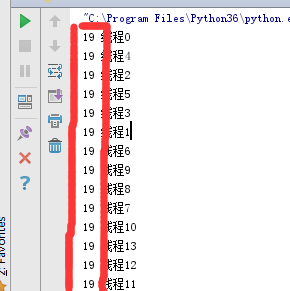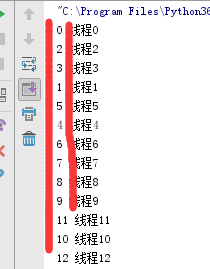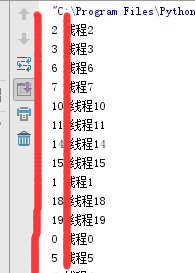Flask上下文管理源码分析 ——(3)
引出的问题
Flask如何使用上下文临时把某些对象变为全局可访问
首先我们做如下的几种情况的假设
情况一:单进程单线程
这种情况可以基于全局变量存储临时的对象
情况二:单进程多线程
这种情况会出现多个线程共享全局的变量,为了每个线程中的数据不被其他线程修改,可以借助hreading.local对象,为每个线程做唯一的表示用来做键,请求的对象作为值来实现
多线程共享数据的问题
import threading class Foo(object): def __init__(self): self.name = 0 local_values = Foo() def func(num): local_values.name = num import time time.sleep(1) print(local_values.name, threading.current_thread().name) for i in range(20): th = threading.Thread(target=func, args=(i,), name='线程%s' % i) th.start()
我们可以看到最后把每个线程中对象中name值都变为了19,不能保证每个线程中对象中的值唯一

使用hreading.local对象可以对每个线程做唯一的表示可以解决上述的问题
import threading local_values = threading.local() def func(num): local_values.name = num import time time.sleep(1) print(local_values.name, threading.current_thread().name) for i in range(20): th = threading.Thread(target=func, args=(i,), name='线程%s' % i) th.start()
可以看到每个线程中的值唯一

- 情况三:单进程单线程(多个协程)Flask 的上下文管理就是基于这种情况做的
在这种情况下使用上面的方法可以保证线程中的数据唯一,但是使用其内部创建多个协程后,hreading.local只能对线程作唯一的标示,协程是在单线程下切换的,所以多个协程还会出现共享数据的问题
解决的思路:为每个程做唯一的标示,我们可以通过python自带的greenlet模块中的getcurrent来实现
只需对上面的代码做简单的修改即可
import threading try: from greenlet import getcurrent as get_ident # 协程 except ImportError: try: from thread import get_ident except ImportError: from _thread import get_ident # 线程 class Local(object): def __init__(self): self.storage = {} self.get_ident = get_ident def set(self,k,v): ident = self.get_ident() origin = self.storage.get(ident) if not origin: origin = {k:v} else: origin[k] = v self.storage[ident] = origin def get(self,k): ident = self.get_ident() origin = self.storage.get(ident) if not origin: return None return origin.get(k,None) local_values = Local() def task(num): local_values.set('name',num) import time time.sleep(1) print(local_values.get('name'), threading.current_thread().name) for i in range(20): th = threading.Thread(target=task, args=(i,),name='线程%s' % i) th.start()
测试的结果如下

使用面向对象中方法对其进行简单的优化
在初始化的时候设置属性的时候,为了避免循环引用,我们可以这样做 object.__setattr__(self, 'storage', {})
class Foo(object): def __init__(self): object.__setattr__(self, 'storage', {}) # self.storage = {} def __setattr__(self, key, value): self.storage = {'k1':'v1'} print(key,value) def __getattr__(self, item): print(item) return 'df' obj = Foo() # obj.x = 123 # 对象.xx
修改后的代码如下所示
import threading try: from greenlet import getcurrent as get_ident # 协程 except ImportError: try: from thread import get_ident except ImportError: from _thread import get_ident # 线程 class Local(object): def __init__(self): object.__setattr__(self, '__storage__', {}) object.__setattr__(self, '__ident_func__', get_ident) def __getattr__(self, name): try: return self.__storage__[self.__ident_func__()][name] except KeyError: raise AttributeError(name) def __setattr__(self, name, value): ident = self.__ident_func__() storage = self.__storage__ try: storage[ident][name] = value except KeyError: storage[ident] = {name: value} def __delattr__(self, name): try: del self.__storage__[self.__ident_func__()][name] except KeyError: raise AttributeError(name) local_values = Local() def task(num): local_values.name = num import time time.sleep(1) print(local_values.name, threading.current_thread().name) for i in range(20): th = threading.Thread(target=task, args=(i,),name='线程%s' % i) th.start()
偏函数 (帮助我们传递参数)
import functools
def func(a1):
print(a1)
new_func = functools.partial(func,666)
new_func()
运行结果如下

面向对象中的魔法方法的简单使用
import flask.globals
class Foo(object):
def __init__(self,num):
self.num = num
def __add__(self, other):
data = self.num + other.num
return Foo(data)
obj1 = Foo(11)
obj2 = Foo(22)
v = obj1 + obj2
print(v.num)
运行结果如下

chain 帮助我们拼接列表中的值
from itertools import chain
# def f1(x):
# return x + 1
#
# func1_list = [f1,lambda x:x-1]
#
# def f2(x):
# return x + 10
#
#
# new_fun_list = chain([f2],func1_list)
# for func in new_fun_list:
# print(func)
v1 = [11,22,33]
v2 = [44,55,66]
new = chain(v1,v2)
for item in new:
print(item)
测试结果如下

Flask上下文源码分析
Flask中有两种上下文,请求上下文和应用上下文。
Flask上下文大致可以分为3个步奏
1 请求到来的时候(为每个线程/协程开辟独立的空间,存入statck中)
- ctx = 封装RequestContext(request,session)
- ctx放到Local中
2 执行视图函数的时候(调用每个线程自己的数据)
- 导入request
- 调用 _lookup_req_object函数:去local中将requestContext想获取到,再去requestContext中获取request或session
3- 请求结束(把数据从stack中删除)
- ctx.auto_pop()
- ctx从local中移除。
当程序启动时执行run方法中的 run_simple方法
请求上下文 (request,session)
封装请求相关的数据
def run(self, host=None, port=None, debug=None, load_dotenv=True, **options): _host = '127.0.0.1' _port = 5000 server_name = self.config.get('SERVER_NAME') sn_host, sn_port = None, None if server_name: sn_host, _, sn_port = server_name.partition(':') host = host or sn_host or _host port = int(port or sn_port or _port) options.setdefault('use_reloader', self.debug) options.setdefault('use_debugger', self.debug) options.setdefault('threaded', True) cli.show_server_banner(self.env, self.debug, self.name, False) from werkzeug.serving import run_simple try: run_simple(host, port, self, **options) finally: # reset the first request information if the development server # reset normally. This makes it possible to restart the server # without reloader and that stuff from an interactive shell. self._got_first_request = False
当请求来的时候会执行 run_simple中的self对象,也就是app.__call__方法,代码如下
def __call__(self, environ, start_response):
return self.wsgi_app(environ, start_response)
查看源码中的wsgi_app方法,参数environ表示所有请求的数据,start_response表示响应
def wsgi_app(self, environ, start_response): # 将请求相关的数据environ 封装到request_context 对象中 ctx = self.request_context(environ) # 生成一个类 error = None try: try: # 把请求的对象封装到local中,每个线程 / 协程都是独立的空间存储 ctx.push() response = self.full_dispatch_request() except Exception as e: error = e response = self.handle_exception(e) except: error = sys.exc_info()[1] raise return response(environ, start_response) finally: if self.should_ignore_error(error): error = None # 最后把请求在local中的数据删掉 ctx.auto_pop(error)
在上面的源码中我们可以看到把所有请求相关的数据封装到了,self.request_context(environ)中,其返回一个RequestContext赋值给ctx我们继续追踪其内部的代码如下所示
def request_context(self, environ): # self指的是app对象 return RequestContext(self, environ)
我们可以看到RequestContext类对environ进行了封装,在这里我们可以看到session的数据为None其初始化的方法如下:
class RequestContext(object): def __init__(self, app, environ, request=None): self.app = app if request is None: request = app.request_class(environ) self.request = request self.url_adapter = app.create_url_adapter(self.request) self.flashes = None self.session = None self._after_request_functions = [] self.match_request()
把请求相关的数据添加到Local对象的storage中
我们继续追踪wsgi_app中的ctx.push的代码如下
def push(self): top = _request_ctx_stack.top if top is not None and top.preserved: top.pop(top._preserved_exc) app_ctx = _app_ctx_stack.top if app_ctx is None or app_ctx.app != self.app: app_ctx = self.app.app_context() app_ctx.push() self._implicit_app_ctx_stack.append(app_ctx) else: self._implicit_app_ctx_stack.append(None) if hasattr(sys, 'exc_clear'): sys.exc_clear() # self 是request_contenx的对象,其中包含了请求相关的所有数据 # _request_ctx_stack==>LocalStack _request_ctx_stack.push(self) if self.session is None: session_interface = self.app.session_interface self.session = session_interface.open_session( self.app, self.request ) if self.session is None: self.session = session_interface.make_null_session(self.app)
在最下面我们看到了给session中的数据重新赋了值
我们查看_request_ctx_stack类和其内部的push方法,把请求封装后的数据_request_ctx当做参数传递进去
_request_ctx_stack = LocalStack()
继续追踪LocalStack类中的push方法代码如下
def push(self, obj): """Pushes a new item to the stack""" rv = getattr(self._local, 'stack', None) if rv is None: # 执行local 对象的__setatr__方法 self._local.stack = rv = [] # 把requestContext 对象添加到列表中 self._local.stack = rv = [把requestContext] rv.append(obj) return rv
在上面的源码中有一个赋值的操作self._local.stack=rv=[],self.local=local()会触发local()对象中的__setatr__方法参数key=stack,value=[],其__setatr__方法代码如下所示
def __setattr__(self, name, value): # name = stack value = [] # {"唯一的表示": # {stack:[requestContext(ctx)]} ident = self.__ident_func__() storage = self.__storage__ try: storage[ident][name] = value except KeyError: storage[ident] = {name: value}
ident = self.__ident_func__() 表示的是为线程/协程做唯一的标示,也就以为者当前的请求的上下文添加到了这样的一个字典中
继续追踪LocalStack类中的push方法中的下rv.append(obj),把当前请求相关的数据添加到stoage中,obj是请求相关的数据RequestCotent,
{
"线程/协助的唯一表示" : {"stack":["当前请求相关的数据"]}
}
当请求结束的时候删除storage中的,当前请求的数据
我们回去继续追踪wsgi_app中 ctx.auto_pop(error)方法删除请求结束后的数据
request和session使用内部调用源码分析
from flask import Flask,request
其代码如下
from functools import partial from werkzeug.local import LocalStack, LocalProxy def _lookup_req_object(name): top = _request_ctx_stack.top if top is None: raise RuntimeError(_request_ctx_err_msg) # 去requestContext中获取request的值 return getattr(top, name) def _lookup_app_object(name): top = _app_ctx_stack.top if top is None: raise RuntimeError(_app_ctx_err_msg) return getattr(top, name) def _find_app(): top = _app_ctx_stack.top if top is None: raise RuntimeError(_app_ctx_err_msg) return top.app # context locals _request_ctx_stack = LocalStack() _app_ctx_stack = LocalStack() current_app = LocalProxy(_find_app) # partial 偏函数 request = LocalProxy(partial(_lookup_req_object, 'request')) session = LocalProxy(partial(_lookup_req_object, 'session')) g = LocalProxy(partial(_lookup_app_object, 'g'))
在上面的源码中,我们可以看到request是一个LocalProxy对象,其内部的参数通过偏函数partial调用_lookup_req_object函数传的参数默认为'request",_lookup_req_object代码如下
def _lookup_req_object(name):
top = _request_ctx_stack.top
if top is None:
raise RuntimeError(_request_ctx_err_msg)
# 去requestContext中获取request的值
return getattr(top, name)
top调用的是_app_ctx_stack= LocalStack()类中的top方法,代码如下
def top(self): """The topmost item on the stack. If the stack is empty, `None` is returned. """ try: return self._local.stack[-1] except (AttributeError, IndexError): return None
其返回的是存储在storage{"stack":{"当前请求":[RequestContent(当前请求的数据)]}},中当前请求的数据,也就是RequestContent对象,所以上面的_llokup_req_object.函数返回的是RequestContent中的g
class RequestContext(object): def __init__(self, app, environ, request=None): self.app = app if request is None: request = app.request_class(environ) self.request = request self.url_adapter = app.create_url_adapter(self.request) self.flashes = None self.session = None
所以request = LocalProxy(RequestContent.request)和session= LocalProxy(RequestContent.session)创建一个类,其初始化的方法如下
class LocalProxy(object): __slots__ = ('__local', '__dict__', '__name__', '__wrapped__') def __init__(self, local, name=None): # self.__loacl = local local 指的是request object.__setattr__(self, '_LocalProxy__local', local) object.__setattr__(self, '__name__', name) if callable(local) and not hasattr(local, '__release_local__'): # "local" is a callable that is not an instance of Local or # LocalManager: mark it as a wrapped function. object.__setattr__(self, '__wrapped__', local)
通过上面的赋值我们可以知道,最终把RequestContent.reques赋值给self.local = RequestContent.reques
补充知识:面向对象的通过通过私有字段的取值
class Foo(object): def __init__(self): self.name = 'alex' self.__age = 18 def get_age(self): return self.__age obj = Foo() # 强制获取私有字段 print(obj._Foo__age)
当我们使用request中的方法的时候,会执行其内部的魔法方法如:
- print(request) --> LocalProxy对象的__str__ - request.method --> LocalProxy对象的__getattr__ - request + 1 --> LocalProxy对象的__add__
通过以上Flask源码的解读,我们可以试着传递一些值做一些简单的修改
from flask.globals import _request_ctx_stack from functools import partial def _lookup_req_object(name): # name = request # top= ctx top = _request_ctx_stack.top if top is None: raise RuntimeError('不存在') # return ctx.request return getattr(top, name) class Foo(object): def __init__(self): self.xxx = 123 self.ooo = 888 req = partial(_lookup_req_object,'xxx') xxx = partial(_lookup_req_object,'ooo') # 当前求刚进来时 _request_ctx_stack.push(Foo()) # 使用 # obj = _request_ctx_stack.top # obj.xxx v1 = req() print(v1) v2 = xxx() print(v2) # 请求终止,将local中的值移除 _request_ctx_stack.pop()
后台打印的结果如下

应用上下文(current__app,g)
源码wsgi_app
def wsgi_app(self, environ, start_response): # 将请求相关的数据environ 封装到request_context 对象中 # ctx.app = app # ctx.request = app.request_class(environ) ctx = self.request_context(environ) # 生成一个类 error = None try: try: # 把请求的对象封装到local中,每个线程 / 协程都是独立的空间存储 ctx.push() response = self.full_dispatch_request() except Exception as e: error = e response = self.handle_exception(e) except: error = sys.exc_info()[1] raise return response(environ, start_response) finally: if self.should_ignore_error(error): error = None # 最后把请求在local中的数据删掉 ctx.auto_pop(error)
追踪ctx.push代码如下
def push(self): top = _request_ctx_stack.top if top is not None and top.preserved: top.pop(top._preserved_exc) app_ctx = _app_ctx_stack.top if app_ctx is None or app_ctx.app != self.app: # 应用上下文 创建一个对象 app_ctx = AppContext(object) app_ctx.g app_ctx.app app_ctx = self.app.app_context() app_ctx.push() self._implicit_app_ctx_stack.append(app_ctx) else: self._implicit_app_ctx_stack.append(None) if hasattr(sys, 'exc_clear'): sys.exc_clear() # self 是request_contenx的对象,其中包含了请求相关的所有数据 # _request_ctx_stack==>LocalStack _request_ctx_stack.push(self) if self.session is None:
session_interface = self.app.session_interface self.session = session_interface.open_session( self.app, self.request ) if self.session is None: self.session = session_interface.make_null_session(self.app)
app_cxt = self.app.app_context() 的源码了解到其返回的是一个AppContext对象
def app_context(self): return AppContext(self)
AppContext源码如下
class AppContext(object): def __init__(self, app): self.app = app self.url_adapter = app.create_url_adapter(None) self.g = app.app_ctx_globals_class() # Like request context, app contexts can be pushed multiple times # but there a basic "refcount" is enough to track them. self._refcnt = 0
我们追踪g变量的源码发现其用法类似字典
class _AppCtxGlobals(object): def get(self, name, default=None): return self.__dict__.get(name, default) def pop(self, name, default=_sentinel): if default is _sentinel: return self.__dict__.pop(name) else: return self.__dict__.pop(name, default) def setdefault(self, name, default=None): return self.__dict__.setdefault(name, default)
回到上面的代码 app_ctx对象,从中我们可以拿到app_ctx和app_ctx.app这就是我们要找的应用上下文了
继续追踪 app_ctx.push()源码如下
def push(self):
self._refcnt += 1
if hasattr(sys, 'exc_clear'):
sys.exc_clear()
_app_ctx_stack.push(self)
appcontext_pushed.send(self.app)

追踪 _app_ctx_stack = LocalStack()中的push方法
def push(self, obj): """Pushes a new item to the stack""" rv = getattr(self._local, 'stack', None) if rv is None: # 执行local 对象的__setatr__方法 self._local.stack = rv = [] # 把requestContext 对象添加到列表中 self._local.stack = rv = [把requestContext] rv.append(obj) return rv
在上面的源码中有一个赋值的操作self._local.stack=rv=[],self.local=local()会触发local()对象中的__setatr__方法参数key=stack,value=[],其__setatr__方法代码如下所示
def __setattr__(self, name, value):
# name = stack value = []
# {"唯一的表示":
# {stack:[requestContext(ctx)]}
ident = self.__ident_func__()
storage = self.__storage__
try:
storage[ident][name] = value
except KeyError:
storage[ident] = {name: value}
继续追踪LocalStack类中的push方法中的下rv.append(obj),把当前请求相关的数据添加到stoage中,obj是请求相关的数据RequestCotent,
{
"stack" : {"线程/协助的唯一表示":["当前请求相关的数据"]}
}
g变量和 current_app
from flask import Flask,g,current_app
其代码如下
from functools import partial from werkzeug.local import LocalStack, LocalProxy def _lookup_req_object(name): top = _request_ctx_stack.top if top is None: raise RuntimeError(_request_ctx_err_msg) # 去requestContext中获取request的值 return getattr(top, name) def _lookup_app_object(name): top = _app_ctx_stack.top if top is None: raise RuntimeError(_app_ctx_err_msg) return getattr(top, name) def _find_app(): top = _app_ctx_stack.top if top is None: raise RuntimeError(_app_ctx_err_msg) return top.app # context locals _request_ctx_stack = LocalStack() _app_ctx_stack = LocalStack() current_app = LocalProxy(_find_app) # partial 偏函数 request = LocalProxy(partial(_lookup_req_object, 'request')) session = LocalProxy(partial(_lookup_req_object, 'session')) g = LocalProxy(partial(_lookup_app_object, 'g'))
在上面的源码中,我们可以看到g是一个LocalProxy对象,其内部的参数通过偏函数partial调用_lookup_app_object函数传的参数默认为'g",_lookup_app_object代码如下
def _lookup_req_object(name):
top = _request_ctx_stack.top
if top is None:
raise RuntimeError(_request_ctx_err_msg)
# 去requestContext中获取request的值
return getattr(top, name)
top调用的是app_cxt = LocalStack() 类中的top方法,代码如下
def top(self):
"""The topmost item on the stack. If the stack is empty,
`None` is returned.
"""
try:
return self._local.stack[-1]
except (AttributeError, IndexError):
return None
其返回的是存储在storage{"stack":{"当前请求":[RequestContent(当前请求的数据)]}},中当前请求的数据,也就是RequestContent对象,所以上面的_llokup_req_object.函数返回的是AppContext中的g
class AppContext(object): def __init__(self, app): self.app = app self.url_adapter = app.create_url_adapter(None) self.g = app.app_ctx_globals_class() # Like request context, app contexts can be pushed multiple times # but there a basic "refcount" is enough to track them. self._refcnt = 0
所以g= LocalProxy(AppContext.g) 和 current_app = LocalProxy(AppContext.app)创建一个类,其初始化的方法如下
class LocalProxy(object):
__slots__ = ('__local', '__dict__', '__name__', '__wrapped__')
def __init__(self, local, name=None):
# self.__loacl = local local 指的是request
object.__setattr__(self, '_LocalProxy__local', local)
object.__setattr__(self, '__name__', name)
if callable(local) and not hasattr(local, '__release_local__'):
# "local" is a callable that is not an instance of Local or
# LocalManager: mark it as a wrapped function.
object.__setattr__(self, '__wrapped__', local)
当我们使用g和current_app 中的方法的时候,会执行其内部的魔法方法如:
- print(g) --> LocalProxy对象的__str__
- g.get(')--> LocalProxy对象的__getattr__
多app应用
from werkzeug.wsgi import DispatcherMiddleware from werkzeug.serving import run_simple from flask import Flask, current_app app1 = Flask('app01') app2 = Flask('app02') @app1.route('/index') def index(): return "app01" @app2.route('/index2') def index2(): return "app2" # http://www.oldboyedu.com/index # http://www.oldboyedu.com/sec/index2 dm = DispatcherMiddleware(app1, { '/sec': app2, }) if __name__ == "__main__": app2.__call__ run_simple('localhost', 5000, dm)
with在类中的使用
class SQLHelper(object): def open(self): pass def fetch(self,sql): pass def close(self): pass def __enter__(self): self.open() return self def __exit__(self, exc_type, exc_val, exc_tb): self.close() with SQLHelper() as obj: # 自动调用类中的__enter__方法, obj就是__enter__返回值 obj.fetch('xxxx') # 当执行完毕后,自动调用类 __exit__ 方法
flask的local中保存数据时,使用列表创建出来的栈。为什么用栈?
在写脚本的时候一个线程中执行多个app他们的关系还是嵌套的
- 如果写web程序,web运行环境;栈中永远保存1条数据(可以不用栈)。
- 写脚本获取app信息时,可能存在app上下文嵌套关系。
from flask import Flask,current_app,globals,_app_ctx_stack app1 = Flask('app01') app1.debug = False # 用户/密码/邮箱 # app_ctx = AppContext(self): # app_ctx.app # app_ctx.g app2 = Flask('app02') app2.debug = True # 用户/密码/邮箱 # app_ctx = AppContext(self): # app_ctx.app # app_ctx.g with app1.app_context():# __enter__方法 -> push -> app_ctx添加到_app_ctx_stack.local # {<greenlet.greenlet object at 0x00000000036E2340>: {'stack': [<flask.ctx.AppContext object at 0x00000000037CA438>]}} print(_app_ctx_stack._local.__storage__) print(current_app.config['DEBUG']) with app2.app_context(): # {<greenlet.greenlet object at 0x00000000036E2340>: {'stack': [<flask.ctx.AppContext object at 0x00000000037CA438> ]}} print(_app_ctx_stack._local.__storage__) print(current_app.config['DEBUG']) print(current_app.config['DEBUG'])
打印的数据如下

关于g变量简单的使用
我们可以在请求到来的时候,给用户赋予一些权限,在视图函数中使用
from flask import Flask,request,g app = Flask(__name__) @app.before_request def before(): g.permission_code_list = ['list','add'] @app.route('/',methods=['GET',"POST"]) def index(): print(g.permission_code_list) return "index" if __name__ == '__main__': app.run()

